
Beijing’s residents are friendly, polite, and helpful. I noticed the same thing in 1994 (though I had forgotten), especially compared to Guangzhou’s famously unfriendly residents. For example, I rarely worry about being overcharged just because I look like I’m from out of town. And on the subway, someone always gives a seat to the kids so they don’t have to stand.
The neighbors have been very helpful in helping us get oriented. One family loaned us a pair of pet turtles to entertain the kids during our stay. The neighbors we know are mostly the ones with small kids who play outside. I have no idea who lives immediately below, above, or next to us.
Foreigners are common enough in Beijing — perhaps one in a thousand — so no one pays me any particular attention, and people generally assume that I speak Chinese. The kids, in contrast, attract a lot of attention, especially 3-year-old Sophia. Foreign kids are not too common, and kids with only one Chinese parent seem uncommon. People stare, say “hi,” reach out to pat the kids, and pause to watch them go by. We leave a wake of “how cute!” and “how pretty!” wherever we go, even in our neighborhood and in stores that we’ve visited many times.
 |
Nearby shopping options include Wal-Mart, Jin Wu Xin (gold five star), and an American-style, upscale shopping mall.
In many ways, Wal-Mart is what you’d expect: a combination department store and grocery with reliably low prices. The selection is much smaller and much different, of course. People who live in small apartments need different household items, and the food selection caters to local taste.
Jin Wu Xin is more typical of Chinese shopping. It’s arranged somewhat like a department store: women’s clothes over here, office supplies over there, etc. It’s run more like a flea market. That is, instead of aisles of shelves, it’s an organized collection of individually run booths; instead of Wal-Mart-style declared prices, you get the best deal by playing neighboring booths off each other. Meanwhile, with so many people running the show, the selection is much larger and more varied.
The shopping mall is a shopping mall. Few of the stores are the same as the ones that are in all American malls, but the concept and layout is the same. More interesting is the area around the shopping mall: Zhong Guan Cun’s electronics district. It’s a block or two of large, modern buildings filled with vendors (Jin Wu Xin style) who sell computers, peripherals, electronics, and software. I think everyone in Beijing must travel to this block to buy computer equipment. Prices on computer systems are similar to prices in the U.S., since competition is fierce is both places at that level. Peripherals, in contrast, seem much cheaper, probably because more competition persists at that level.
The same competitive pressure keeps food cheap. Streetside vendors sell bread, buns, deep-fried chicken, kabobs, fruit, deep-fried seafood, and bread with fried eggs. In fact, China was an instant hit with the kids, because minutes after we arrived at our apartment, we walked 150 yards and bought breakfast. Oliver was amazed to have so much food that he liked so close, and for prices on the scale of money in his own wallet. Our first family breakfast cost nearly a dollar. The kids have since adapted to the local scale of travel, and they consider the three-block trip to school or Jin Wu Xin to be a long journey.
When we first arrived, we travelled mostly by taxi, and we still use taxis for medium trips — 10 yuan (about $1.25) for the first 3 kilometers. When we tell taxi drivers that we live close to the place for paying traffic fines, they never have trouble finding our small street. For a trip into town, we take the subway, mostly to avoid traffic. For short trips, such as school, we use the family vehicle.
The family vehicle is an electric tricycle, with a rear-facing seat in the back that’s just big enough for Wen and the kids. I used to call it the minivan version of a bicycle. Then we bought a tent for the back, so it looks like this:
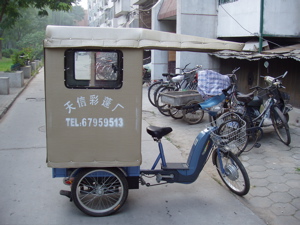 | 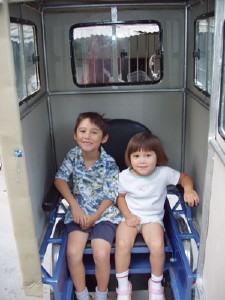 |
I feel as conspicuous driving it as I would a limousine, but it’s a common sort of vehicle here1 (though more for hauling the old than for kids, because a bicycle is enough for moving one small child). In fact, since the kids are now less visible on the ride to and from school, we attract less attention than before.
Here are scenes from the trip to school, where traffic is reliably heavy for fifteen minutes each morning near the elementary school:
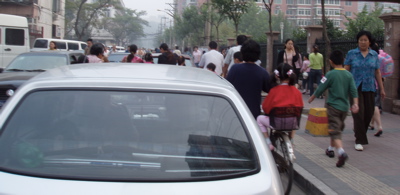 | 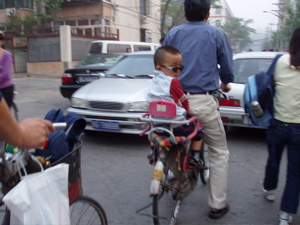 |
On local roads, traffic is a mixture of cars, cycles, and pedestrians — in roughly equal proportions and with roughly equal blame for jams. Most large roads have a wide bike lane, though it’s often infested with taxis. Intersections have a traffic light for cars, another for pedestrians, and a third for bikes; the lights are not ignored entirely. During peak hours, crossing guards act as a kind of conscience to keep travellers more or less in line. As a tricycle driver, I still occasionally confuse a pedestrian by pausing to let them pass, but I’m getting better.
Our kids attend a pre-school/kindergarten that is close to the elementary school:
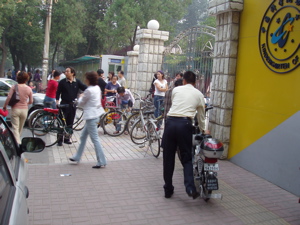 | 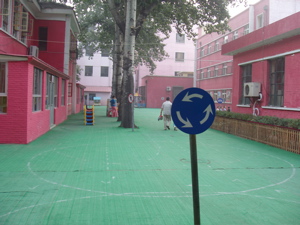 |
Each class has 20–30 kids with 3–4 teachers, and the school has about ten classes. Oliver does very well, and seems to be picking up relevant Chinese quickly. Sophia’s having a rougher time with school, but so did Oliver at that age, and she’s usually happy. The teachers have been very patient. Most kids stay in school all day, but we have the luxury of bringing ours home after lunch.
| 1 | I now know that it requires some effort for locals to pretend that a foreigner on a tricycle is perfectly normal. Occassionally, in traffic, someone will pull up from behind and glance over to see me. They are often visibly surprised to see a non-Chinese face, but they quickly recover their composure and look away. A tiny minority hold the stare and smile, or they comment on my unusual choice of transport. |
| Prev: Welcome to Beijing | Contents: A Year in China: 2006-2007 | Next: Food: The Restaurant Scene |